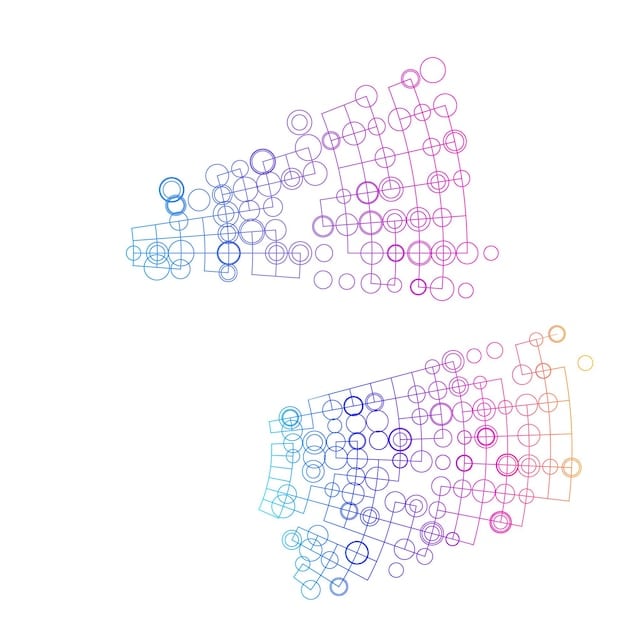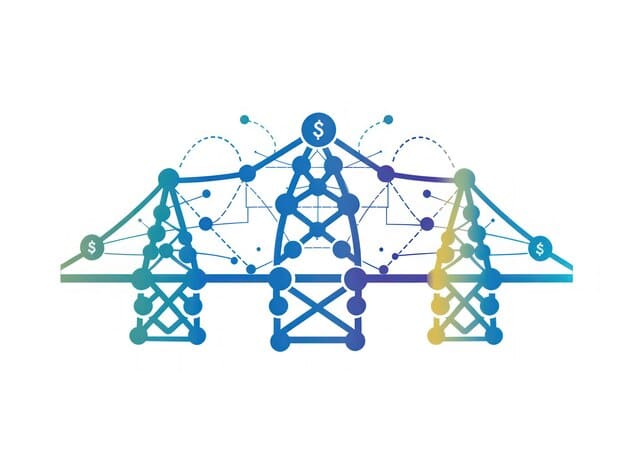Blockchain Interoperability: Connecting US Businesses in 2025

Blockchain interoperability is the ability of different blockchain networks to communicate, share data, and transact with each other, enabling US businesses to leverage diverse blockchain solutions and create more efficient, integrated systems in 2025.
In 2025, the landscape of blockchain technology is poised to transform, making blockchain interoperability: connecting different blockchains for US businesses in 2025 a crucial topic. This article explores the importance, challenges, and opportunities of interoperability for US companies in the evolving blockchain ecosystem.
Understanding Blockchain Interoperability
Blockchain interoperability enables different blockchain networks to seamlessly communicate and share data. This connectivity is vital for unlocking the full potential of blockchain technology across various industries.
What is Blockchain Interoperability?
Blockchain interoperability refers to the ability of different blockchain networks to interact, share data, and execute transactions with each other without intermediaries. It allows for the transfer of assets and information between disparate blockchain systems.
Why is Interoperability Important?
Interoperability is crucial as it breaks down silos between different blockchain platforms, fostering a more integrated and efficient blockchain ecosystem. This integration enhances the utility and scalability of blockchain applications.

Here are some key benefits of blockchain interoperability:
- Enhanced Efficiency: Streamlines processes by allowing seamless data transfer and transactions across different blockchains.
- Increased Scalability: Distributes workload across multiple networks, improving overall throughput and capacity.
- Innovation: Facilitates the creation of new and innovative applications by combining the strengths of different blockchain technologies.
In conclusion, blockchain interoperability is essential for realizing the promise of a decentralized and interconnected future. It enables businesses to leverage the unique advantages of various blockchain platforms while maintaining seamless integration and efficiency.
Current Challenges in Blockchain Interoperability
Despite its potential, achieving seamless blockchain interoperability faces several significant challenges. These challenges range from technical complexities to regulatory uncertainties.
Technical Challenges
One of the primary hurdles is the heterogeneity of blockchain protocols. Different blockchains use varying consensus mechanisms, data structures, and smart contract languages, making direct communication difficult.
Security Concerns
Ensuring the security of cross-chain transactions is another major concern. Vulnerabilities in one blockchain could potentially be exploited to compromise the security of interconnected networks.
Here are some specific challenges that need to be addressed:
- Standardization: Lack of standardized protocols for cross-chain communication hinders interoperability efforts.
- Scalability Limitations: Current interoperability solutions may introduce scalability bottlenecks.
- Regulatory Uncertainty: The absence of clear regulatory frameworks complicates the implementation of interoperable blockchain solutions.
In summary, while blockchain interoperability offers immense potential, overcoming these technical and security challenges is crucial for its widespread adoption. Addressing these issues will pave the way for a more secure and efficient blockchain ecosystem.
Emerging Interoperability Solutions
To overcome the challenges of blockchain interoperability, several innovative solutions are being developed. These solutions aim to bridge the gaps between different blockchain networks.
Cross-Chain Bridges
Cross-chain bridges are protocols that enable the transfer of assets and data between different blockchains. They work by locking assets on one chain and minting equivalent assets on another.
Atomic Swaps
Atomic swaps allow for the direct exchange of cryptocurrencies between different blockchains without the need for intermediaries. They use cryptographic techniques to ensure that either both parties fulfill their obligations or neither does.

Here are some notable interoperability projects:
- Polkadot: Aims to enable different blockchains to operate together in a unified network.
- Cosmos: Focuses on creating an “internet of blockchains” through its Inter-Blockchain Communication (IBC) protocol.
- Chainlink: Provides a decentralized oracle network that enables smart contracts to access real-world data and interact with off-chain systems.
In conclusion, emerging interoperability solutions such as cross-chain bridges and atomic swaps are paving the way for a more connected blockchain ecosystem. These advancements promise to unlock new opportunities for businesses by enabling seamless interaction between different blockchain networks.
Benefits of Interoperability for US Businesses in 2025
By 2025, blockchain interoperability is expected to offer significant advantages for US businesses across various sectors. These benefits include increased efficiency, cost savings, and new revenue streams.
Supply Chain Management
Interoperability can streamline supply chain operations by enabling seamless data exchange between different blockchain-based systems used by suppliers, manufacturers, and distributors.
Healthcare
In healthcare, interoperability can facilitate the secure sharing of patient data across different healthcare providers and institutions, improving patient care and reducing administrative overhead.
Here are key areas where US businesses can benefit from interoperability:
- Financial Services: Enables faster and more efficient cross-border payments and settlement processes.
- Retail: Enhances customer loyalty programs by allowing customers to use rewards points across different platforms.
- Real Estate: Simplifies property transactions by enabling seamless data sharing between different parties involved in the process.
In summary, blockchain interoperability is poised to revolutionize various industries in the US by 2025. By enabling seamless data sharing and interaction between different blockchain networks, it promises to drive efficiency, reduce costs, and unlock new opportunities for innovation.
Implementing Interoperable Blockchain Solutions
Successfully implementing interoperable blockchain solutions requires careful planning and execution. US businesses need to consider various factors, including technology selection, security considerations, and regulatory compliance.
Choosing the Right Technology
Selecting the appropriate technology for interoperability is crucial. Businesses should evaluate different solutions based on their specific needs, scalability requirements, and security features.
Ensuring Security
Security must be a top priority when implementing interoperable blockchain solutions. Businesses should implement robust security measures to protect against potential vulnerabilities and attacks.
Consider these crucial steps for successful implementation:
- Conduct a thorough risk assessment to identify potential security threats.
- Implement strong encryption and access control mechanisms.
- Regularly audit and update security protocols to address emerging threats.
In conclusion, implementing interoperable blockchain solutions requires careful planning, technology selection, and a strong focus on security. By taking these steps, US businesses can successfully leverage the benefits of interoperability while minimizing potential risks.
Future Trends in Blockchain Interoperability
The field of blockchain interoperability is rapidly evolving, with several exciting trends on the horizon. These trends promise to further enhance the capabilities and adoption of interoperable blockchain solutions.
Advancements in Cross-Chain Communication
New protocols and technologies are being developed to improve the efficiency and security of cross-chain communication. These advancements will enable faster and more reliable data transfer between different blockchains.
Increased Adoption of Standards
Efforts are underway to establish industry standards for blockchain interoperability. The adoption of standardized protocols will facilitate greater compatibility and interoperability between different blockchain systems.
FAQ
| Key Point | Brief Description |
|---|---|
| 🔗 Interoperability Definition | Enables different blockchains to communicate and share data. |
| 🛡️ Security Concerns | Ensuring cross-chain transactions are secure. |
| 🌉 Cross-Chain Bridges | Protocols that transfer assets between blockchains. |
| 🏢 US Business Benefits | Improves efficiency and opens new revenue streams. |
Frequently Asked Questions
Blockchain interoperability is the ability of different blockchain networks to communicate, share data, and transact with each other. It allows for the integration of disparate blockchain systems.
Interoperability enables US businesses to leverage diverse blockchain solutions, improve efficiency, and create new revenue streams by seamlessly integrating different blockchain networks.
Challenges include the heterogeneity of blockchain protocols, security concerns related to cross-chain transactions, and the lack of standardized protocols for cross-chain communication.
Emerging solutions include cross-chain bridges, which enable the transfer of assets between blockchains, and atomic swaps, which allow for direct cryptocurrency exchanges without intermediaries.
US businesses should carefully select the right technology, prioritize security, and comply with regulatory requirements to successfully implement interoperable blockchain solutions. Risk assessment is also important.
Conclusion
In conclusion, blockchain interoperability is a critical development for US businesses looking to leverage the full potential of blockchain technology in 2025. Overcoming the challenges and embracing emerging solutions will drive efficiency, innovation, and new opportunities across various industries.





